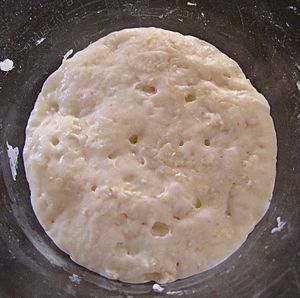Biga (bread baking) facts for kids
Biga is a special kind of pre-ferment used in Italian baking. Think of it as a starter dough that helps make bread taste amazing! Many popular Italian breads, like ciabatta, are made with biga.
Using biga makes bread taste richer and more complex. It also helps create a light, open texture with lots of holes, which is perfect for many Italian breads. Besides adding great flavor and texture, biga helps bread stay fresh longer.
Contents
Why Bakers Started Using Biga
Biga techniques became popular after baker's yeast was invented. Before that, bakers often used sourdough starters. When they switched to baker's yeast, they noticed some of the deep flavors were missing. Biga was developed to bring back that wonderful taste.
What Makes Biga Special
Biga is usually quite dry and thick compared to a sourdough starter. This thickness is thought to give biga its unique, slightly nutty flavor.
How Biga is Made
Biga is typically made fresh every day. It uses a small amount of baker's yeast mixed into a thick dough. The amount of water in the dough can vary a lot, from 45% to 90% of the flour's weight. This dough then ferments (or rests) for about 12 to 16 hours. This long rest allows the flavors to fully develop.
Biga for Home Bakers
Sometimes, when people bake at home, they use the word biga to mean a naturally leavened sourdough. This type of biga uses a stiff sourdough starter and does not include baker's yeast.
See also
 In Spanish: Biga (masa de harina) para niños
In Spanish: Biga (masa de harina) para niños


